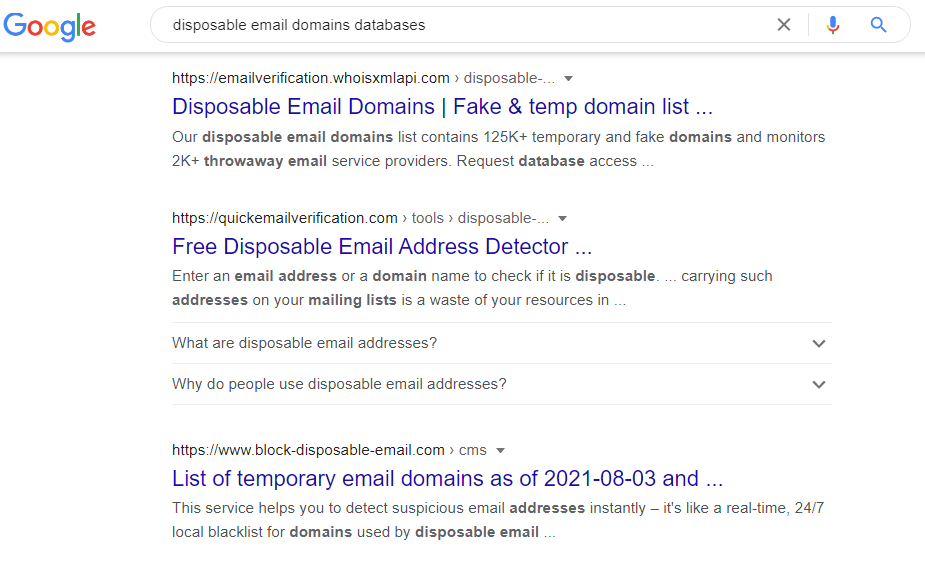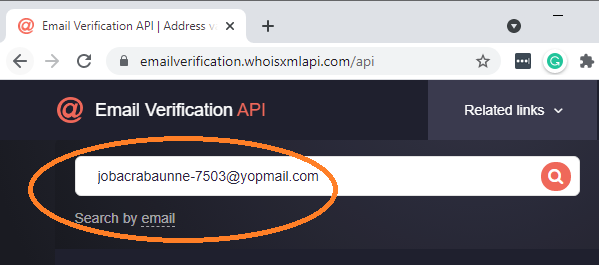How to Detect Disposable Email Addresses?
Last Updated :
21 Sep, 2021
Disposable email addresses are commonly created for one-time use only. People often utilize them to sign up for accounts to avoid getting too many marketing emails in their official email inboxes. Several disposable email domain providers offer addresses that can only be used for a specific amount of time.
While disposable or temporary email addresses are useful for privacy protection, businesses may need to find ways to detect them. Suppose you own a software-as-a-service (SaaS) business that operates on a freemium model. You may want to detect disposable email addresses and encourage users to sign up with their official ones instead. That way, you can reduce the likelihood of freemium abuse, as well as ensure you can reach users via email. Otherwise, your email marketing efforts might be negatively affected. You may end up with a high bounce rate and low conversion rates.
Method 1: Check If an Email Domain Is Part of a Third-Party Disposable Email Domains Database
Follow the below steps to check if an Email domain is part of a third-party disposable Email domains database:
Step 1: Look for a disposable email domains database provider. Type in “disposable email domains database” on Google or other search engines.

Step 2: Choose a third-party provider. Most of the items on a search results page would be disposable email domains lists from third-party providers, like this one, for example. Please note that the databases offered by different vendors could vary in terms of price, coverage, and recency.
Step 3: Download the disposable email domains database. For more accurate results, download a database offered by a provider with the most updated data.

Step 4: Determine the domain of the email address. The email domain is the text string that comes after the @ symbol. If someone signed up using the email address johndoe@summis[.]com, the email domain is summis[.]com.

Step 5: Check if the email domain is listed in the disposable email domains database. Search for the email domain by pressing CTRL+F (for Windows computers) or Command-F (for Macs). If you find the email domain in the database, the email address is disposable. In our example, johndoe@summis[.]com is a disposable email address since its email domain is listed in the database.

Method 2: Use Data from Repository Management Platforms
Follow the below steps to use data from repository management platforms to detect disposable Emails:
Step 1: Go to a repository management platform or website. Some commonly used ones are GitHub Gist and Pastebin. Select the platform you’re most comfortable using.
Step 2: Search for a list of disposable email domains on GitHub Gist. Type “disposable email domains” into the search field and sort the results with the most recently updated ones on top.

Step 3: Search for lists of disposable email domains on Pastebin. Searching on Pastebin may be a challenge since there is no search bar. A workaround is to type pastebin.com disposable email domains on Google or other search engines.

Step 4: Determine the domain of the email address.
Step 5: Check if the email domain is in the list of disposable email domains. From the list, search for the email domain by pressing CTRL+F (for Windows computers) or Command-F (for Macs). If you find the email domain in the database, the email address is disposable.
Step 6: Perform step 5 on multiple lists. You may need to check several sources of disposable email domains to ensure accuracy. The email domains found on these lists come from other members and are mostly from blocklist sites. As such, they may not be the most complete or updated, so it’s best to check multiple sources.
Method 3: Automate Disposable Email Address Detection Using Email Verification Tools
Follow the below steps to automate disposable email address detection using Email verification tools:
Step 1: Select the type of email verification tool. You can use an application programming interface (API) or a web-based application to detect disposable email addresses. Email verification APIs can be integrated into websites and applications so any email address entered into these systems are automatically checked. On the other hand, web-based email verification tools require you to input email addresses into the vendors’ platforms.
Step 2: Search for an email verification tool provider. You can do that via Google or other search engines but you may also utilize online marketplace intermediaries like Capterra and G2. Type “email verification API” or “email verification tool” into the search field.

Step 3: Enter the email address you want to verify. Use the search box on the vendor’s website to type the email address you need to check. Let us use jobacrabaunne-7503@yopmail[.]com as an example.

Step 4: Click the Search button. Clicking the button will create an API call (for email verification APIs) or perform a lookup (for email verification lookup tools). Either way, that will check the email domain against the disposable email domains database integrated into the tool. The command will also tell the tool to perform other checks. For instance, most tools would also check if the email address follows the standard syntax and has an existing mail server.
Step 5: Check if the email address is disposable. From the results, look for the field that indicates whether the email address is disposable or not. “True” means that the email address is disposable, while “false” means the opposite. Other tools may use different indicators, such as “yes” and “no” or a checkmark and a cross.

The three ways we demonstrated are a mix of manual and automated methods to detect disposable email addresses. The choice would ultimately depend on your capability. If you have the time to do it manually, then you can follow the methods that use disposable email domains databases. Otherwise, using an email verification API or lookup tool would be more suitable.
Like Article
Suggest improvement
Share your thoughts in the comments
Please Login to comment...